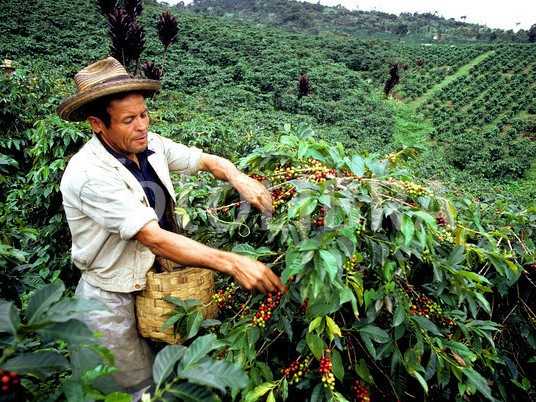USDA GAIN semi-annual report on Colombia estimates that Colombian coffee production will increase to 14.0 million bags GBE in MY 2015/16 (October through September), slightly up from the previous forecast of 13.6 million bags GBE.
Revised production forecast for MY 2016/17 is up from 13.3 to 14.0 million bags GBE as drought conditions were favorable for the flowering period and projected rainfall is expected to be normal for the next months.
The National Federation of Coffee Growers of Colombia (FEDECAFE) estimates that average coffee productivity has increased to 15 bags per hectare from 10 bags per hectare as a result of the replanting program which reduced the average age of coffee trees from 15 to 7 years.
The rust resistant variety replanting program and minimal impacts of El Niño weather phenomena have helped to maintain strong productivity during MY 2015/16, up 5.1% from the previous year.
In MY 2015/16, Post revises export estimates to 12.5 million bags GBE paralleling the increase in production, up from the previous estimate of 12.3 million bags GBE.
Revised MY 2016/17 exports are forecast up from 12.4 to 12.8 million bags GBE, given the large beginning stocks as a result of the 45-day trucker’s strike which reduced the availability of transportation from the coffee regions in MY 2015/2016.
Since mid-2015, internal prices have shown an upward trend driven by devaluation of Colombian peso and international commodity markets behavior.
Given this increase, the Government of Colombia (GOC) continues to suspend the Protection for the Income of Farmers (PIC) subsidy program.
Production
Colombia coffee production is at record levels not seen since the early 1990’s as a result of the highly successful replanting program of coffee rust resistant varieties and good weather.
Post revised estimates for Colombian coffee production are 14.0 million bags GBE in MY 2015/16, higher than previous estimates of 13.6 million bags GBE. Production exceeds expectations and remains strong as a result of mild impacts from the El Niño drought.
The new Post forecast for MY 2016/17 is up from 13.3 to 14.0 million bags GBE as production continues to recover despite predicted negative effects of weather patterns.
Actually, drought impacts on flowering period have been favorable on the main coffee harvest of October to December, 2016.
In addition, the IDEAM reduced the probability of potential flooding conditions from La Niña towards the end of 2016 and the first half of 2017, which would have affected the flowering period for the MY 2016/17 second or mitaca harvest and would have increased the spread of coffee rust, known as roya.
Current production is estimated at 14 million bags GBE, which exceeds historical averages, signaling a complete turnaround of the devastating impacts of coffee rust from 2008-2012.
The last marketing year with production exceeding 14 million bags GBE was in 1992/93.
Despite the production recovery, medium and large scale coffee growers are struggling to maintain quality of beans as a consequence of a shortage of agricultural labor and a higher minimum wage.
Less farmworkers in the field detrimentally impacts production and control of insect pests, such as the coffee cherry borer. Farmworker labor to conduct field observation and clearing the soil of fallen cherries are critical to managing borer outbreaks.
Borer infestation levels are less than 5% of planted area, but reports indicate that drought conditions increased farm infestations in the central region where shortage of labor is present.
The borer impacts the coffee quality resulting in price discounts at points of sale. FEDECAFE developed the Plan Harvest or Plan Cosecha which consists of recruiting labor from rural and other areas of the country to work in the central region fields during the main harvest period and mitigate quality problems.
The average size of the Colombian coffee farm is 4.5 hectares of land. FEDECAFE estimates there are 560,000 coffee growing families, where small farmers with less than 5 hectares of land are responsible for approximately 69 percent of coffee production in Colombia.
There are 950,000 hectares of coffee planted in Colombia but only 780,000 correspond to technified crops which mean they are partially planted with improved coffee varieties, as rust resistant trees, dense plantations and are younger than 12 years.
Consumption
Driven by an increasing number of coffee shops and new coffee products, such as coffee pods, domestic consumption is estimated to reach 1.5 million bags GBE for MY2015/16, increasing further more in MY 2016/17, up to 1.6 million bags GBE.
Local coffee consumption is boosted by an increasing number of Juan Valdez coffee shops and small, consumer oriented coffee stores with high quality coffee or specialty coffee.
Other companies with a presence in this market include Illy, OMA and the mega-coffee retailer, Starbucks, which started operations in Colombia in 2014.
Although Starbuck’s sales are below Juan Valdez and OMA cafes, the growth rate in 2015 was much higher than its competitors.
Coffee shops in Colombia are primarily oriented towards satisfying the preferences of young professionals with espresso and gourmet coffee beverages.
Trade
Colombian coffee exports are expected to increase to 12.5 million bags GBE in MY 2015/16, slightly above Post’s May 2016 estimate of 12.2 million bags.
In MY 2016/17, Post estimates Colombian coffee exports will increase further at 12.8 million bags GBE.
Colombian coffee exports have been expanding significantly since 2013, paralleling the recovery in coffee production.
In mid-2016, Colombia faced a trucker strike that paralyzed the country’s highways and obstructed ports resulting in plunging coffee exports. However, since last August coffee exports rebounded, as piled up bags are shipped.
The United States is the major single destination for Colombian coffee, importing 41.4 percent of all Colombian coffee exports, with Japan, Germany, Belgium, and Canada importing 11, 8, 8, and 7 percent, respectively.
In order to add more value to Colombian coffee, the Colombia industry is implementing a policy that promotes the export of quality coffee that meets higher cupping and grading standards.
Value added, specialty coffee now comprises close to 40 percent of Colombia’s total coffee exports.
Colombian specialty coffee is booming with certified and organic coffees receiving significant price premiums, typically higher than traditional coffee exports.
Coffee denomination of origin labels from specific regions of Colombia, such as the southern growing regions of Huila, Cauca and Nariño, are gaining more international recognition for the cupping quality and further value added.
Colombian specialty coffee growers produce coffee under numerous international programs that provide fair trade and organic certifications such as USDA Organic, UTZ Certified, 4C, and Rainforest Alliance.
Protocols vary between growers and intermediaries, including FEDECAFE, to maintain the levels of quality that will meet certification standards and buyer/consumer expectations abroad.
In an effort to promote direct trading and increase small-scale producer income, FEDECAFE launched an initiative to allow registered exporters to ship coffee in small quantities.
Shipments of up to 60 kilograms of green coffee, roasted coffee, instant coffee and coffee extract, are occurring with authorized private shipping companies.
In spite of the greater volume of production, the El Niño weather phenomena increased the presence of the coffee berry borer which affected the quality of Colombia’s beans.
As a result of the increase in the quantity of grains of inferior quality, coffee soluble exports increased by 15% to 825,000 bags GBE in MY 2015/16.
Domestic prices are managed by FEDECAFE and based on the daily quote of the New York Coffee, Sugar and Cocoa Exchange (NYCSCE) less estimated costs for internal transport and administration.
In MY 2015/16, the average internal price of coffee reached 786,463 Colombian Pesos (COP) per 125 kilogram bag, up 8.4% from the MY 2014/15.
Stocks
There exists no GOC or FEDECAFE policy to support large scale carry-over stocks of coffee.
Post estimates for MY 2015/16 beginning stocks totaled 666,000 bags GBE. In MY 2016/17 beginning stocks will increase to 926,000 bags GBE considering enlarged production and stored bags due to the trucker’s strike.
In MY 2016/17 ending stocks will fall to 726,000 bags GBE given that there is no policy incentive or infrastructure to maintain long term stocks, in addition to the surge of internal prices and the weaker Colombian peso, which offers more economic incentives to trade.
Policy
The coffee sector has historically played a large role in Colombia’s economic success, providing a livelihood for an estimated 560,000 producers and their families, giving FEDECAFE significant political influence.
Most growers are members of FEDECAFE and take advantage of the organization’s educational programs, technical training, and sales support.
FEDECAFE purchases coffee from its members at an internal price which parallels the international commodity markets less some administrative and internal transport expenses.
The FEDECAFE price acts as a floor price should farmers not procure higher price premiums for specialty coffee through other buyers and intermediaries.
The PIC subsidy program that began on March 18, 2013, was cancelled for the latter half of 2014 and remains suspended as prices have peaked above the PIC trigger price.
Other GOC and FEDECAFE programs were created to support coffee growers affected by drought conditions in MY 2015/2016.
These programs were focused on providing inputs and other mechanisms to boost production in the drought-affected coffee farms.
FEDECAFE provides technical assistance and permanent support to coffee producers through the extension service in order to increase farm productivity and family income.
The extension service assists growers on good practices for planting, harvest and post-harvest, as well as productive phases that have an impact on the final quality of coffee.
In addition, FEDECAFE manages low interest loan programs for the costs of replanting; however, loans are only offered for planting the rust resistant Castillo variety.
The GOC also offers financial assistance for all agricultural commodities through the Rural Funding Incentive program (ICR), which provides loans with discounted payback terms.
Additionally, a special loan category supported by the GOC Financing Fund for Agricultural Sector (FINAGRO), was established for drought impacted farms.
The same instrument was also created to support small growers in replanting their coffee fields.
Most of the policies and programs for the coffee sector are sponsored by the National Coffee Fund which is a parafiscal account whose contributions are made exclusively by Colombian coffee growers.
The Fund’s resources are managed by FEDECAFE. The monitoring of policies and programs is made by a committee composed of government officials and coffee grower representatives.
Production, Supply and Demand Data Statistics











